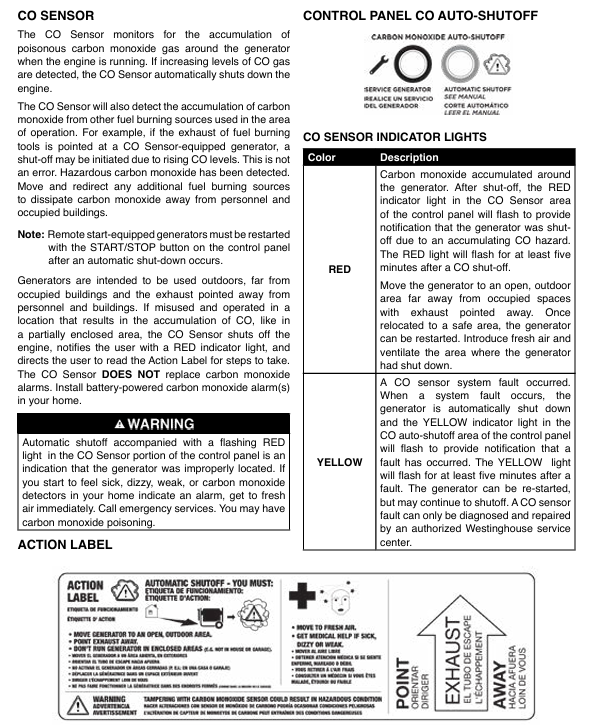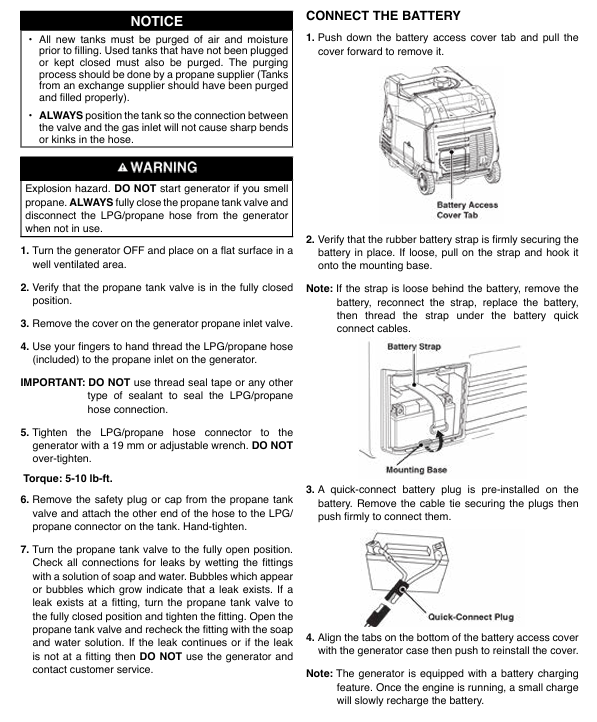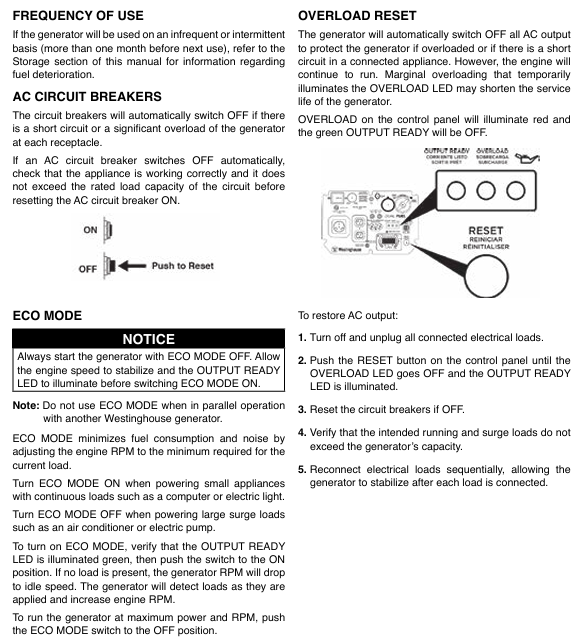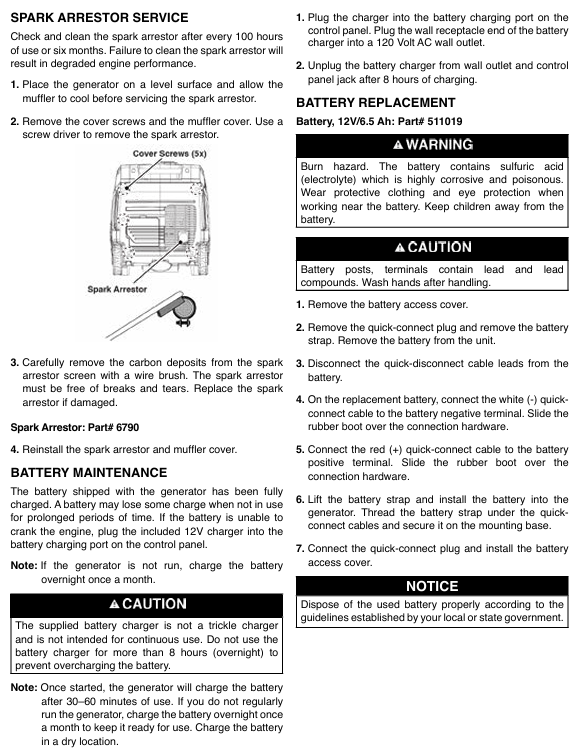

K-WANG


Westinghouse iGen4500DFc Dual Fuel Digital Variable Frequency Generator
Westinghouse iGen4500DFc Dual Fuel Digital Variable Frequency Generator
Core parameters and positioning of the product
1. Basic specifications
Power parameters: gasoline mode - rated power 3700W, peak power 4500W; propane mode - rated power 3330W, peak power 4050W, supports 120V single-phase output, frequency 60Hz, total harmonic distortion ≤ 3% (suitable for sensitive electronic devices).
Power configuration: 224cc engine, supports manual start, electric start, remote start (up to 30 meters), fuel tank capacity of 12.8L (3.4 gallons), oil capacity of 0.6L (0.63 US quarts), recommended oil model 10W-30.
Fuel compatibility: Gasoline requires octane rating of 87-93 (ethanol content ≤ 10%, E15/E85 prohibited); Propane supports standard gas cylinders with overcharge protection device (OPD) and is compatible with hose connections.
Environmental adaptability: The working temperature range is -9.4 ° C~50 ° C (5 ° F~122 ° F), with a maximum ambient temperature of 40 ° C (104 ° F). The power decreases by 3.5% for every 1000 feet (approximately 305 meters) increase in altitude.
2. Core positioning and advantages
Dual fuel flexible switching, higher power in gasoline mode, cleaner and safer storage in propane mode, suitable for different usage scenarios.
With the support of frequency conversion technology, low noise (in ECO mode) and low harmonic distortion, it can safely supply power to sensitive electronic devices such as computers and televisions.
Equipped with multiple safety protections (low fuel automatic shutdown, overload protection, CO sensor automatic shutdown), outdoor use is more reassuring.
Supports parallel operation (requires separate purchase of parallel lines), can be combined with compatible Westinghouse generators to increase total output power.

Core functions and operation guide
1. Core functional features
Dual fuel switching: The control panel is equipped with a fuel selection switch, which supports switching during operation (propane cylinders need to be connected in advance). During switching, the engine may briefly become unstable, which is a normal phenomenon.
Startup method:
Remote start: Use the matching keychain remote control with an effective distance of 30 meters and a 2-cell CR2016 battery model.
Electric start: First, turn on the battery switch and press the start button on the control panel.
Hand pulled start: Suitable for when the battery is low, slowly pull the rope until there is resistance and then quickly pull it.
ECO mode: After being turned on, the engine speed automatically adjusts with the load, reducing fuel consumption and noise, suitable for low-power continuous loads (such as lamps and computers); It is recommended to turn off ECO mode for high-power devices such as air conditioning and water pumps.
safeguard:
CO sensor: monitors the concentration of carbon monoxide in the surrounding area, automatically shuts down when it exceeds the standard, and the red indicator light flashes to give an alarm.
Low oil protection: When the oil level is below the safe value, it will automatically shut down and light up the low oil indicator light.
Overload protection: When the load exceeds the rated power, the circuit breaker trips, the overload indicator light lights up, and a power-off reset is required.
Output configuration: The control panel includes a 20A dual socket (NEMA 5-20R), a 30A RV dedicated socket (NEMA TT-30R), two 5V/2.1A USB interfaces, and supports parallel operation interfaces (requiring dedicated parallel wires).
2. Key operational steps
(1) First use preparation
Add engine oil: The new machine has no engine oil and needs to be filled with the recommended 10W-30 engine oil to the L-H mark on the dipstick. Overfilling is prohibited.
Connecting fuel:
Gasoline: Open the fuel tank cap and add 87-93 gasoline to the red filling ring in the tank. Do not overfill and tighten the fuel tank cap.
Propane: Connect one end of the matching hose to the propane interface of the generator (manually tighten, no need for raw material tape), and the other end to a gas cylinder. Use soapy water to check if the interface leaks (if it bubbles, it is a leak and needs to be re tightened).
Connect the battery: Open the battery compartment cover, connect the quick connector, and ensure that the battery is securely fixed.
(2) Start operation
Gasoline mode: Turn the fuel selection switch to gasoline mode → open the fuel tank valve → press the start button (or remote start, manual start) → wait for the output ready indicator light (green) to light up, then connect the load.
Propane mode: Turn the fuel selection switch to propane mode → fully open the cylinder valve → press the start button → connect the load after the output is ready.
(3) Shutdown and fuel switching
Normal shutdown: First disconnect all loads → let the generator run without load for a few minutes → press the stop button (or turn off the battery switch) → in propane mode, the gas cylinder valve needs to be closed.
Fuel switching (in operation):
Gasoline propane cutting: Open the cylinder valve → switch the fuel switch to propane mode → close the fuel tank valve.
Propane to gasoline: Open the fuel tank valve → switch the fuel switch to gasoline mode → close the cylinder valve.

Installation and usage specifications
1. Installation and placement requirements
It must be used outdoors with good ventilation, at least 5 feet (about 1.5 meters) away from doors, windows, and ventilation openings. It is prohibited to use it indoors, in garages, basements, and other enclosed spaces to prevent carbon monoxide poisoning.
Place on a dry, flat, hard surface to avoid sand, grass debris, and other debris blocking the heat dissipation outlet. Leave a ventilation space of 5 feet (about 1.5 meters) around it.
Grounding requirements: If connecting to the building power supply system, a professional electrician must install a conversion switch and ground it; When only using a socket for power supply, there is no need for additional grounding (neutral line floating design).
2. Extension cords and load usage
Extension cables should use outdoor dedicated and grounded 3-core wires, with wire diameter specifications that match the load and length (recommended wire diameter ≥ 12AWG and length ≤ 50 feet for 20A loads).
Load management: All loads need to be disconnected during startup, and connected sequentially after startup. First, connect high-power devices (such as refrigerators and air conditioners), and then connect low-power devices to avoid overloading caused by starting multiple high-power devices at the same time.
Power adaptation: The total operating power should be ≤ rated power, and the starting power should be ≤ peak power (for example, if the starting power of a 1/3 horsepower water pump is about 2000W, sufficient margin should be reserved).
3. Parallel operation (parallel wires need to be purchased separately)
Only compatible Westinghouse variable frequency generators can be connected in parallel, with a total rated power of up to 7400W (dual engine gasoline mode).
Operation steps: Turn off two generators → Connect parallel wires (black to black interface, red to red interface, green grounding wire) → Start two generators in sequence → Connect the load after the output is ready, and prohibit parallel connection in ECO mode.

Maintenance and upkeep
1. Regular maintenance schedule
Maintenance project cycle operation content
Check the oil level before each use or after every 8 hours of operation, and replenish it if it is below the L mark
25 hours or 1 month after the first oil change; After heating up every 50 hours or 6 months, drain the oil and replace it with new oil. When installing the drain bolt, replace the copper washer
Clean the air filter Take out the foam filter element every 50 hours or 6 months, clean it with detergent, dry it and soak it with engine oil (squeeze out the excess engine oil) Reinstall
Spark plug maintenance check every 100 hours; Replace inspection gap (0.60-0.80mm) every 300 hours or 1 year, clean carbon deposits, and replace if damaged (recommended model F7RTC)
Clean the Mars extinguisher every 100 hours or 6 months. Remove the muffler cover, clean the carbon buildup on the filter screen, and replace it if it is damaged
When the battery is not used for a long time, it should be charged for 8 hours per month using the matching charger (no more than 8 hours to avoid overcharging)
2. Storage specifications
Short term storage (within 1 month): No special handling is required. Close the fuel valve and place it in a dry and ventilated place, covered with a dust cover (plastic cover is prohibited to avoid moisture).
Mid term storage (2-6 months): Add fresh fuel and fuel stabilizer, empty the carburetor float chamber of fuel, and disconnect the battery connector.
Long term storage (more than 6 months): Drain the fuel tank and carburetor, inject a small amount of engine oil into the cylinder, pull the pull rope to put the piston in the compression stroke (close the valve), disconnect the battery, and store in a dry and ventilated place.
Safety precautions
1. Core security warning
Risk of carbon monoxide poisoning: Only for outdoor use, keep away from doors, windows, and ventilation openings. Install a carbon monoxide alarm at home. If symptoms such as dizziness and nausea occur, immediately move to fresh air and seek medical attention.
Fire and explosion risks: Smoking and staying away from open flames are prohibited when refueling. Contact with mufflers (high temperature) is prohibited when heating up. Propane cylinders should be placed upright on the ground, away from heat sources and direct sunlight.
Electric shock risk: Do not use in damp environments or rainy days. Do not touch the socket when your hands are wet. The equipment should be placed in a dry place to avoid water accumulation.
2. Fuel safety
Gasoline storage: Use approved gasoline containers, store in a well ventilated area, away from sources of ignition, and prohibit long-term storage in the generator fuel tank.
Propane use: Check that the hose is not damaged or bent, close the cylinder valve after use, disconnect the hose during transportation, and fix the cylinder upright.
Troubleshooting
Unable to start without engine oil, fuel not turned on, spark plug wet/carbon deposits. Add engine oil, open fuel valve, dry or replace spark plug
Immediately stop the machine after starting, low oil, CO sensor alarm, overload and replenish oil, move to a ventilated area, and disconnect the overload load
No output power circuit breaker tripping, excessive load, socket fault resetting circuit breaker, reducing load, checking socket connection
Unstable operation, fuel impurities, clogged air filter, insufficient propane pressure. Replace with fresh fuel, clean air filter, and check propane cylinder pressure
Poor performance in propane mode due to low cylinder temperature and hose leakage. Move to a warm environment and check the leak point with soapy water and tighten it

- YOKOGAWA
- Energy Access
- Renewable Integration
- Energy Subsidies
- Energy and Water
- Net zero emission
- Energy Security
- Critical Minerals
- A-B
- petroleum
- Mine scale
- Energy and Gender
- Covid-19
- man-machine
- Reliance
- ADVANCED
- SEW
- ProSoft
- WATLOW
- Kongsberg
- FANUC
- VSD
- DCS
- PLC
- Sewage treatment
- cement
- Yaskawa
- Woodward
- BOSCH Rexroth
- MOOG
- General Electric
- American NI
- Rolls-Royce
- CTI
- Honeywell
- EMERSON
- Construction site
- xYCOM
- electricity
- Industrial information
- New energy
- Automobile market
- Motorola
- HIMA
- ABB
- Rockwell
- Schneider Modicon
- Siemens
- architecture
- MAN
- GE
- TRICONEX
- Control Wave
- ALSTOM
- AMAT
- STUDER
- KONGSBERG
- MOTOROLA
- DANAHER MOTION
- Bentley
- Galil
- EATON
- MOLEX
- Triconex
- DEIF
- B&W
- ZYGO
- Aerotech
- DANFOSS
- KOLLMORGEN
- Beijer
- Endress+Hauser
- schneider
- Foxboro
- KB
- REXROTH
- YAMAHA
- Johnson
- Westinghouse
-
Kollmorgen S33GNNA-RNNM-00 - Brushless Servo Motor
-
Kollmorgen 6sm56-s3000-g-s3-1325 - Servo Motor
-
Kollmorgen AKM52K-CCCN2-00 - Servo Motor
-
Kollmorgen PSR3-230/75-21-202 - Power Supply
-
Kollmorgen akm24d-anc2r-00 - Servo Motor
-
Kollmorgen AKM22E-ANCNR-00 - Servo Motor
-
Kollmorgen S60300-550 - Servo Drive
-
Kollmorgen B-204-B-21 - Servomotor
-
Kollmorgen AKM21E-BNBN1-00 - Servo Motor
-
Kollmorgen TT2953-1010-B - DC Servo Motor
-
Kollmorgen pa8500 - Servo Power Supply
-
Kollmorgen BDS4A-210J-0001-207C2 - Servo Drive
-
Kollmorgen TTRB1-4234-3064-AA - DC Servo Motor
-
Kollmorgen MH-827-A-43 - Servo Motor
-
Kollmorgen AKM24D-ACBNR-OO - Servo Motor
-
Kollmorgen 00-01207-002 - Servo Disk DC Motor
-
Kollmorgen AKM21C-ANBNAB-00 - Servo Motor
-
Kollmorgen PSR3-208/50-01-003 - Power Supply
-
Kollmorgen 6SM56-S3000 - Servo Motor
-
Kollmorgen DBL3H00130-B3M-000-S40 - Servo Motor
-
Kollmorgen 6SN37L-4000 - Servo Motor
-
Kollmorgen AKM65K-ACCNR-00 - Servo motor
-
Kollmorgen 6SM56-L3000-G - Servo Motor
-
Kollmorgen AKMH43H-CCCNRE5K - Servo Motor
-
Kollmorgen PSR4/52858300 - Power Supply
-
Kollmorgen KBM-79H03-E03 - Direct Drive Rotary Motor
-
Kollmorgen AKM33E-ANCNDA00 - Servo Motor
-
Kollmorgen U9M4/9FA4T/M23 - ServoDisc DC Motor
-
Kollmorgen AKM13C-ANCNR-00 - Servo Motor
-
Kollmorgen AKM43L-ACD2CA00 - Servo Motor
-
Kollmorgen AKM54K-CCCN2-00 - Servo Motor
-
Kollmorgen M-605-B-B1-B3 - Servo Motor
-
Kollmorgen AKD-P00606-NBAN-0000 - Rotary Drive
-
Kollmorgen 6SM-37M-6.000 - Servo Motor
-
Kollmorgen A.F.031.5 - Sercos Interface Board
-
Kollmorgen 918974 5054 - Servo PWM
-
Kollmorgen U12M4 - ServoDisc DC Motor
-
Kollmorgen AKD-B00606-NBAN-0000 - Servo Drive
-
Kollmorgen MV65WKS-CE310/22PB - Servo Drive
-
Kollmorgen 65WKS-CE310/22PB - Servo Drive
-
Kollmorgen EM10-27 - Module
-
Kollmorgen S64001 - Servo Drive
-
Kollmorgen CR03200-000000 - Servo Drive
-
Kollmorgen 6SM57M-3000+G - Servo Motor
-
Kollmorgen BDS4 - Servo Drive
-
Kollmorgen AKD-P00306-NBEC-000 - Servo Drive
-
Kollmorgen AKD-B01206-NBAN-0000 - Servo Drive
-
Kollmorgen STP-57D301 - Stepper Motor
-
Kollmorgen 6SM37L-4.000 - Servo Motor
-
Kollmorgen 44-10193-001 - Circuit Board
-
Kollmorgen PRDR9SP24SHA-12 - Board
-
Kollmorgen PRD-AMPE25EA-00 - Servo Drive
-
Kollmorgen DBL3N00130-0R2-000-S40 - Servo Motor
-
Kollmorgen S406BA-SE - Servo Drive
-
Kollmorgen AKD-P00607-NBEI-0000 - Servo Drive
-
Kollmorgen AKD-P01207-NBEC-0000 - Servo Drive
-
Kollmorgen CR03550 - Servo Drive
-
Kollmorgen VSA24-0012/1804J-20-042E - Servo Drive
-
Kollmorgen N2-AKM23D-B2C-10L-5B-4-MF1-FT1E-C0 - Actuator
-
Kollmorgen 04S-M60/12-PB - Servo Drive
-
Kollmorgen H33NLHP-LNW-NS50 - Stepper Motor
-
Kollmorgen A-78771 - Interlock Board
-
Kollmorgen AKM43E-SSSSS-06 - Servo Motor
-
Kollmorgen AKD-P00607-NBEC-0000 - Servo Drive
-
Kollmorgen E21NCHT-LNN-NS-00 - Stepper Motor
-
Kollmorgen cr10704 - Servo Drive
-
Kollmorgen d101a-93-1215-001 - Motor
-
Kollmorgen BDS4A-203J-0001-EB202B21P - Servo Drive
-
Kollmorgen MCSS23-6432-002 - Connector
-
Kollmorgen AKD-P01207-NACC-D065 - Servo Drive
-
Kollmorgen CK-S200-IP-AC-TB - I/O Adapter and Connector
-
Kollmorgen CR10260 - Servo Drive
-
Kollmorgen EC3-AKM42G-C2R-70-04A-200-MP2-FC2-C0 - Actuator
-
Kollmorgen BDS5A-206-01010-205B2-030 - Servo Drive
-
Kollmorgen s2350-vts - Servo Drive
-
Kollmorgen AKM24D-ANC2DB-00 - Servo Motor
-
Kollmorgen E31NCHT-LNN-NS-01 - Stepper Motor
-
Kollmorgen PRD-0051AMPF-Y0 - Servo Board
-
Kollmorgen TB03500 - Module
-
Kollmorgen 60WKS-M240/06-PB - Servo Drive
-
Kollmorgen M21NRXC-LNN-NS-00 - Stepper Motor
-
Kollmorgen H-344H-0212 - Servo Motor
-
Kollmorgen MCSS08-3232-001 - Connector
-
Kollmorgen AKM33H-ANCNC-00 - Servo Motor
-
Kollmorgen PA-2800 - Power Supply
-
Kollmorgen MTC308C1-R1C1 - Servo Motor
-
Kollmorgen PRDR0091300Z-00 - Capacitor Board
-
Kollmorgen BDS4A-206J-0024/01502D79 - Servo Drive
-
Kollmorgen S20330-VTS - Servo Drive
-
Kollmorgen S20250-CNS - Servo Drive
-
Kollmorgen SBD2-20-1105-WO - Servo Drive Board
-
Kollmorgen M405-C-A1--E1 - Servo Motor
-
Kollmorgen PRD-PB805EDD-00 - Servo Drive
-
Kollmorgen 6SM57S-3.000-J-09-HA-IN - Servo Motor
-
Kollmorgen AKM33H-ANCNDA-00 - Servo Motor
-
Kollmorgen PCB-00030200-04 - PCB
-
Kollmorgen H22SSLB-LNN-NS-02 - Stepper Motor
-
Kollmorgen BJRL-20012-110001 - Module
-
Kollmorgen BDS4A-206J-0001404A - Servo Drive
-
Kollmorgen H-342-H-0802 - Servo Motor
-
Kollmorgen CR10561 - Servo Drive
-
Kollmorgen BDS5A-206-00010-205B2-030 - Servo Drive
-
Kollmorgen BDS5A-206-00010-207B-2-030 - Servo Drive
-
Kollmorgen mcss08-3224-001 - Connector
-
Kollmorgen M-207-B-23-B3 - Servo Motor
-
Kollmorgen PRD-0041200Z-S0 - Encoder/Resolver Card
-
Kollmorgen MH-225-G-61 - Motor
-
Kollmorgen MT308B1-T1C1 - Servo Motor
-
Kollmorgen BDS4A-240J-0001604C83 - Servo Drive
-
Kollmorgen 6SM57-S-3000 - Servo Motor
-
Kollmorgen N-T31V-15-5B-6-MF3-FT1E-C251 - Actuator
-
Kollmorgen PRD-0051AMPA-X0 - Servo Board
-
Kollmorgen CF-SS-RHGE-09 - Cable
-
Kollmorgen DIGIFAS7204 - Servo Drive
-
Kollmorgen S30101-NA - Servo Drive
-
Kollmorgen DIGIFAS7201 - Servo Drive
-
Kollmorgen PRD-0051AMPA-Y0 - Servo Board
-
Kollmorgen AKM23D-EFCNC-00 - Servo Motor
-
Kollmorgen SE10000 - Servo Drive
-
Kollmorgen PSR4/5A-112-0400 - Power Supply
-
Kollmorgen AKM31H-ANCNC-01 - Servo Motor
-
Kollmorgen M-203-B-93-027 - Servo Motor
-
Kollmorgen CP-SS-G1HE-05 - Connector
-
Kollmorgen AKM42G-ASCNR-02 - Servo Motor
-
Kollmorgen DBL4N00750-B3M-000-S40 - Servo Motor
-
Kollmorgen R3-BK23-152B-12-PL-ASE-BS115 - Actuator
-
Kollmorgen MH-427-B-61 - Motor
-
Kollmorgen cr06902 - Servo Drive




